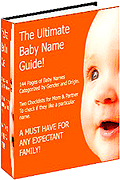Popular Names - Naming Your Baby
by: Parvati Markus
Congratulations! You’ve got a baby on the way!
Once your baby has arrived, one of the most important parts of your new life together will be getting a good night’s sleep — you in your bed, the baby in a safe and comfortable crib. At first, you may want your newborn to sleep in a bassinet by your bed, making it a little easier for breastfeeding moms, but have a crib ready by the time your baby can roll over.
Your baby will spend more time in the crib than anywhere else, so safety is of utmost importance. What makes a crib safe?
* The bars or slats of the crib railing should be no more than 2-3/8" apart, close enough together to prevent your baby’s head from slipping through or getting stuck. That crib in the attic may be a beautiful antique, but it probably does not meet this safety standard. Secondhand older cribs may also have splinters or lead paint as well as slats that are too far apart.
* Cribs with cutout designs along the rail may look pretty, but your baby’s arm or neck could get stuck in them.
* The crib must be sturdy. Your child will sleep in a crib until it’s time to move into a regular bed between the ages of 2 and 3. When shopping for the crib, give it a good shake to see if it wobbles or rattles.
* Construction materials should be stained or painted hardwoods like maple, ash, beech or oak. The use of inferior woods can potentially weaken or warp the slats. Some metal cribs are also very sturdy and secure. All finish materials must be lead free and non-toxic.
* For safety, the dropsides must be at least 9" above the mattress support when lowered. When the side is raised, the top must be at least 26" above the support at its lowest position. You should have no trouble quietly raising and lowering the side rail easily with one hand, since chances are you’ll have a sleeping baby in your arms.
* Make things a little easier on your back by choosing a crib with an adjustable height mattress. A newborn can rest higher in the crib, while a baby who can sit up needs a lower mattress so he can’t climb out. You can change the height of most mattresses by simply raising or lowering the mattress support.
* Check the hardware on the crib for sharp edges or points or anything else that could hurt your baby.
* The mattress should fit snugly into the crib. If you can fit two fingers between the side of the mattress and the crib, it is too small. Keep an eye on foam mattresses; over time, they may break down at the edges and leave gaps. Check the mattress support to make sure there are safety clips that lock the hangers into their notches.
(continued...)
Baby Cribs Safety Checklist
Page 2
About The Author
Parvati Markus Please find the original article and more information about this subject at http://www.homeandliving.com/DesignAdvice.aspx?Category=BabyCribSafety When Parvati Markus is not writing helpful and insightful articles like the one you just read from www.homeandliving.com, she works with The Kabbalah Centre and freelances on non-fiction books and articles. As a recent arrival in L.A., Parvati is completing her “residency requirement” by writing a screenplay. If you would like to publish this article on your own site, please feel free to do so. Please let us know the url of the posted article by emailing the url to articles@homeandliving.com. All we ask is that you include the whole article, without changes, including the link to the original article location, author information, this disclaimer and the following link. Find great home furniture online at www.homeandliving.com.
|
